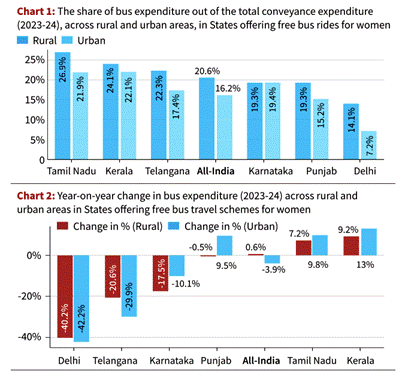Context
A recent World Bank report noted that India lifted approximately 171 million people out of extreme poverty between 2011–12 and 2022–23. Extreme poverty, defined as living on less than $2.15 per day, has declined from 16.2% to 2.3% in this period. However, these statistics prompt further investigation into how household consumption patterns have evolved, particularly regarding expenditure priorities across rural and urban India.
Relevance : GS 1(Society) , GS 2(Social Issues)
Insights from the Household Consumption Expenditure Survey (HCES) 2023–24
1. Overview of Per Capita Expenditure
- Rural India: ₹4,122 per capita per month
- Urban India: ₹6,996 per capita per month
- Expenditure is divided into:
- Food: 47% (rural), 39% (urban)
- Non-food: The remaining share, which includes conveyance, health, education, housing, etc.
- The share of food consumption has declined over time, indicating a gradual shift in expenditure priorities.
2. Conveyance as a Major Non-Food Expense
- Conveyance accounts for 14% of total non-food expenditure on average.
- Bus travel forms the largest component of conveyance costs, particularly in rural areas:
- Rural: 20.6% of conveyance expenditure
- Urban: 16.2% of conveyance expenditure
- Rural dependence on buses is higher due to limited access to alternative transport modes.
3. State-Wise Trends
- High rural bus expenditure: Tamil Nadu, Kerala (around 25% of conveyance spending)
- Low rural bus expenditure: Uttar Pradesh, Odisha, Karnataka, Haryana (less than 20%)
- States offering free bus services for women as of 2025:
- Delhi, Tamil Nadu, Karnataka, Kerala, Telangana, Punjab, Jammu & Kashmir
4. Mixed Policy Impact
- Evidence on the impact of free bus schemes is mixed:
- Reduction in bus expenditure in: Delhi, Karnataka, Telangana
- Increase in bus expenditure in: Tamil Nadu, Kerala
- At a national level:
- Urban India saw a 4% decline in bus expenditure
- Rural India saw a 0.6% increase, indicating limited rural policy impact
5. Income Group and Usage Paradox
- Contrary to expectations, higher-income households spend a larger share of their conveyance budget on buses.
- Possible explanation: Lower-income households (especially in rural areas) have lower transportation needs due to engagement in agriculture.
- No clear link between non-agricultural employment and bus usage in urban areas, suggesting broader usage beyond commuting.

Policy Recommendations
- Electrification of Public Transport:
- Transition from internal combustion engines to electric buses to reduce operational costs and ticket prices.
- Increase Bus Availability:
- Current national average: 17 buses per 1 lakh population
- Ministry benchmark: 60 per 1 lakh
- Poorly served states: Punjab, Uttar Pradesh, Odisha (fewer than 10 buses per 1 lakh people)
- Improve Bus Quality and Affordability:
- Upgrading infrastructure can reduce the economic burden on households, allowing reallocation of resources to health, education, or asset creation.
Conclusion
India’s declining poverty rates and shifting consumption patterns reflect socio-economic progress. However, the findings from HCES underscore persistent infrastructure deficits and uneven policy impact, especially in rural areas. Addressing conveyance costs through targeted investment and systemic improvements in public transport could significantly enhance household welfare and reduce regional disparities.



